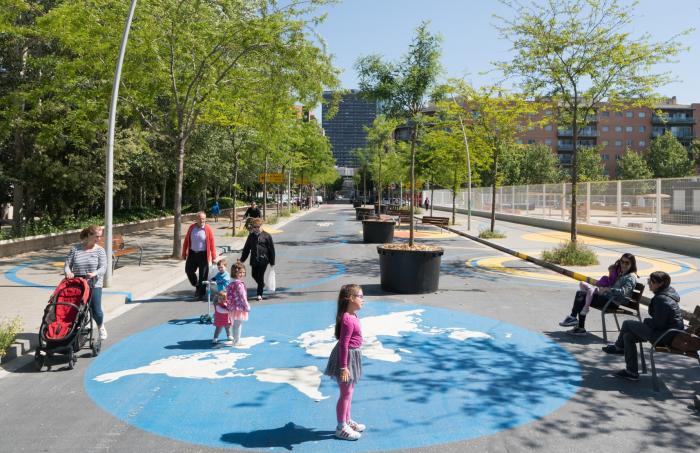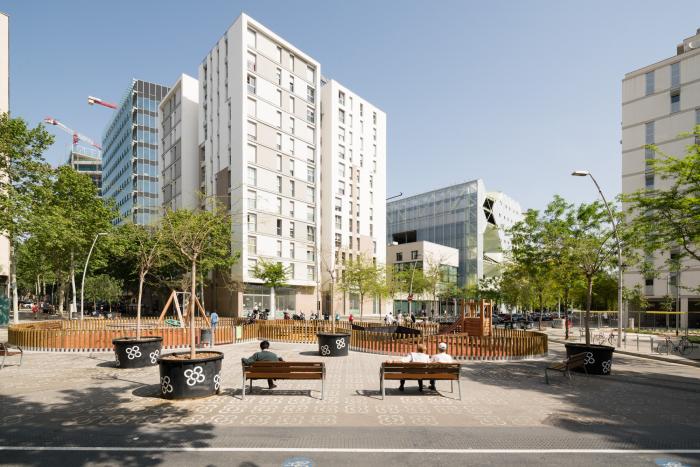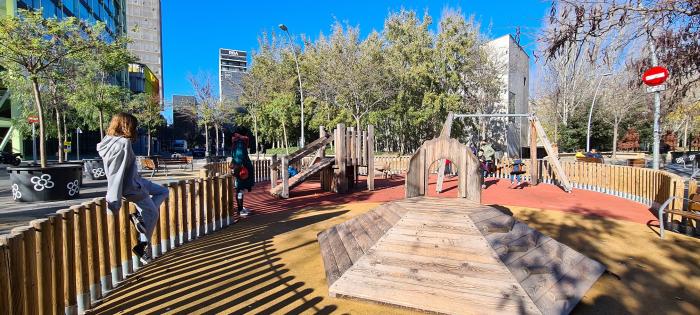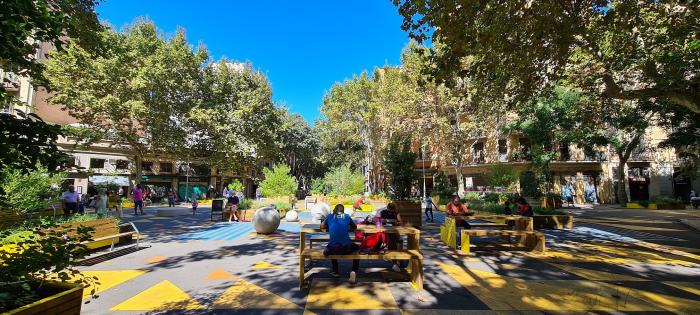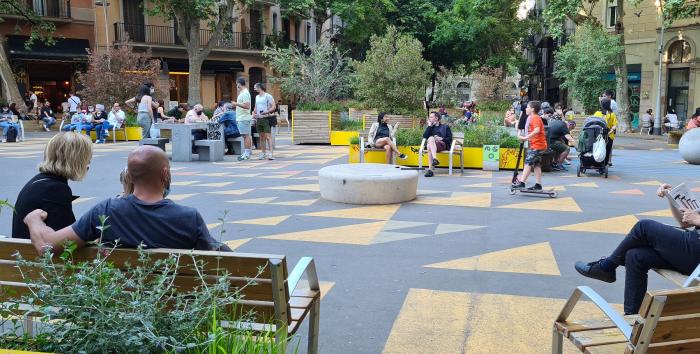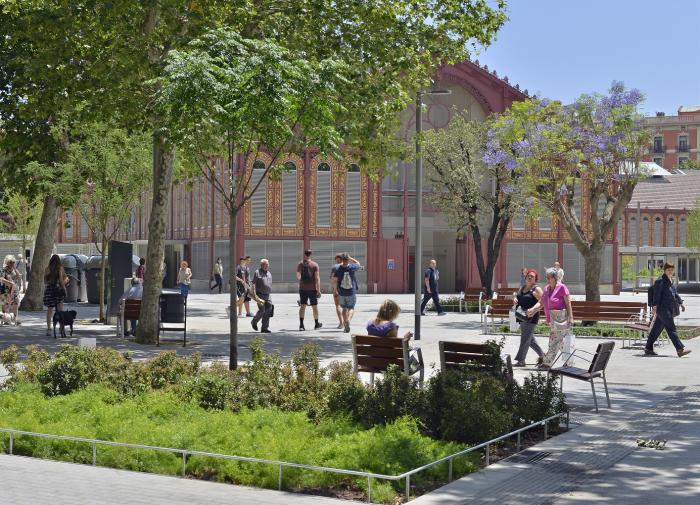I. SUMMARY INFORMATION
Project
269415
Status
Submitted
Award category
Reinvented places to meet and share
You want to submit
NEW EUROPEAN BAUHAUS AWARDS : existing completed examples
Project title
Barcelona Superblock - The city we want
Full project title
Implementation of Superblocks program to change Barcelona Urban Model.
Description
The Superblocks Barcelona came about from the need to rise to the two-fold challenge of improving people's quality of life, by making the city healthier and more liveable, while reducing the impact of urban mobility and ensuring the environment's short -and long-term integrity. Supreblocks is a new model of the city and new way of living the city streets by putting the people in the centre of planning. The project has been implemented in Poblenou and Sant Antoni, among other neighbourhoods.
Where was your project implemented in the EU?
Spain
Catalunya
Barcelona
41º 25’ 10’’ N
02º 07’ 31’’ E
Barcelona
080
When was your project implemented?
Has your project benefited from EU programmes or funds?
No
Which programme(s) or fund(s)? Provide the name of the programme(s)/fund(s), the strand/action line as relevant and the year.
II. DESCRIPTION OF THE PROJECT
Please provide a summary of your project
Barcelona is one of the densest cities in Europe where the need for public space for citizens is even more evident in the current pandemic situation. At the same time, citizens are increasingly demanding more openly, as shown by social movements, the need to have a city with less pollution and noise. For all these reasons, the city of Barcelona has a very determined commitment to adapt public space and mobility to achieve a more liveable city.
The Superblocks Program is a model with vision and transformative capacity for the entire city. It’s a process of sequential transformation of the set of streets in all neighbourhoods and districts of the city. The superblock concept application defines a new map of Barcelona, which highlights the spaces and streets that become greener and a gives priority to pedestrians and cyclists. Therefore, in addition to reordering and making the public transport, bicycle and private mobility networks more efficient, a new pedestrian network is generated, defined from the new green axes that connect the city. This new way of seeing the city that integrates and guides all actions to transform the city's public space.
The objectives of Barcelona Superblocks program are to make a city healthier, more liveable and of short distances. It does so by putting people's health in the foreground, reorganizing the mobility, making it more efficient and safe, while promoting active and sustainable mobility, gaining space for social relationships and aiming to a greener and more naturalized city with rich biodiversity.
The superblocks program has shown that in Barcelona it is possible to move towards a healthier, more equitable and safer public space that favours local social relations and improvement of local economic activities.
Please give information about the key objectives of your project in terms of sustainability and how these have been met
The Superblocks Program, launched since the 2013 Urban Mobility Plan, is a model with vision and transformative capacity for the entire city. It defines a new map of Barcelona, which highlights the spaces and streets that become greener and a gives priority to pedestrians and cyclists by closing streets to through traffic and introducing, in the beginning, tactical urbanism interventions.
In September 2016, the City implemented its first superblock in the Poblenou neighbourhood. Tactical urbanism solutions included temporary installation of street furniture, reversible painted ground signs, and mobile tree planters.
The pedestrian area was increased by 80% and the area occupied by cars was reduced by 48%. New children's playground areas were created (2,500m2), and the green area was increased by 91%. As a consequence of the intervention there was a significant reduction of vehicles that access the pacified streets of Superblock daily, by 58%.
On the other side of the city, in 2018 Superblock Sant Antoni was implemented. Regarding the balance published in end of 2019, this superblock already had first positive results: 23,709 m2 of public space with pedestrian priority has been gained throughout the area, and indicators of pollution, noise, vehicles and neighbourhood use improved. At the Borrell/Tamarit junction, 33% less NO2 in the air and 4% less particulate matter (PM10) has been measured, and the noise level is also low: 4.1 decibels less per day (5.3 less in the afternoon and 5.4 less at night). At the same crossroads, in Borrell Street there is an 82% decrease in the passage of vehicles, almost 6,000 less.
Please give information about the key objectives of your project in terms of aesthetics and quality of experience beyond functionality and how these have been met
Following the first transformative initiatives carried out in areas such as Poblenou and Sant Antoni Superblocks, Barcelona City Council has conducted a detailed analysis of the city: citizen flows and mobility, neighbourhood facilities, green spaces, building and social fabric and so on. It is through this comprehensive approach that a road hierarchy has been created enabling some streets to be freed of road traffic and the creation of a network of green hubs and squares where pedestrians have priority.
These spaces with pedestrian priority gave room for temporary tactical changes when structural changes were planned as a second stage. In that sense, tactical urbanism elements firstly were introduced in 2016 in Poblenou Superblock. Since then, Barcelona has been committed to tactical urbanism when implementing initiatives that require functional changes to be made, quickly and economically, to the way urban space is used. Also, it is a planning tool used in many other cities around the world to rapidly change the way a street is used. Moreover, these are changes that can easily be reversed or adapted if necessary.
In a first phase of the implementation in Poblenou, work was carried out with paint, street furniture and mobile tree planters to create and highlight the living areas, especially dedicated to children and citizen interaction. In total, two large squares at the crossroads have been gained in the area and picnic tables were also placed. As well there were created, progressively and as a result of the process of participation and debate with neighbours and entities, play areas and sports areas. Also, on 2018 the Poblenou Superblock won a mention in the European Prize for Urban Public Space 2018, awarded by the Center for Contemporary Culture of Barcelona. The project also was the finalist in 2017 Award of C40 network in its category.
Please give information about the key objectives of your project in terms of inclusion and how these have been met
The Superblock transformation of public space is helping to create a new map of the city where citizens are the central players. The transformation creates green axes and green paces, with facilities and local shops in a safe and friendly way for people. The space created is inclusive in terms of accessibility to all ages, gender and disabilities. It takes into account the gender perspective and responds specifically to the needs of diverse groups, with special attention to the most vulnerable groups such as children and old people, or people with functional diversity. It is a city project built with dialogue and participation from all stakeholders and citizens.
In Poblenou and Sant Antoni neighbourhoods the implementation was developed through the participatory processes that defined an Action Plan. This plan worked with an Impulsor Group, which monitors and validates the project, with commercial sector, youth, etc. and in an open day to the whole neighbourhood. In the case of the Poblenou superblock we performed the participation once mobility changes were implemented. A day of valuation and proposals was held which was attended by 222 neighbours and in which their opinions were collected. From here the Labor Commission was constituted, where it was deepened in different subjects of the superblock and in which the different proposals were presented by the city council.
The work carried out in the Superblock area in Sant Antoni comes from the process of debate with residents, traders and organizations in the area that began in February 2017, with the constitution of the Impulsor Group. This group, made up of people and entities representing the neighbourhood, has been working together since the beginning with Barcelona City Council, with the aim of setting up what the Superblock model proposal should be in this area.
Specifics workshops with blinded people have been held in order to improve the safety perception of this vulnerable group.
Please give information on the results/impacts achieved by your project in relation to the category you apply for
Barcelona is moving towards a model of public space that is more sustainable, healthier and designed for people. A model that promotes social relations, local commercial activity and focuses on the needs of children and the elderly in the city. This new model integrates the perspective of health from all areas. It is planned to reduce private traffic, reduce pollution, promote sustainable and active mobility and reduce noise, reducing the risk of diabetes and other respiratory and cardiovascular diseases, introducing more intensely the green of proximity and making more welcoming public space, strengthening social relations and improving physical and mental health. In this new model, walking routes are prioritized, which strengthens the idea of proximity to the compact and mixed city like Barcelona. Through Supeblocks implementation, it is being created the network that connects green spaces, facilities, municipal markets and local shops in a safe and friendly way for people.
As mentioned, 23,709 m2 of public space with pedestrian priority has been gained throughout the area of Sant Antoni, 28% more of pedestrians in this area, 82% less vehicles. In Poblenou, the sidewalks have been widened and new spaces for pedestrians have been added in which new activities can be organized. A total of 25,129m2 has been gained, reaching 56,665m2. In addition, 349 new seating places have been installed; benches and chairs, and 2,483m2 of new children's playground areas. The pedestrian area has been increased by 80% and the area occupied by cars has been reduced by 48%. Also, the number of active economic activities in the ground floor has gone from 65 to 85, an increase of 30.7% which contributes to the revitalization of the area.
Please explain the way citizens benefiting from or affected by the project and civil society have been involved in the project and what has been the impact of this involvement on the project
Barcelona City Council advocates a more sustainable city model that tackles the challenge of improving the quality of people's lives, making the city more liveable and healthier. With the paradigm shift and the reversed priority of space for vehicles becoming public areas, the city is freeing up space for social use. Other benefits include: empowering people, particularly children and the elderly, given the fear that traffic generates; fostering of intergenerational relationships through public areas where people can meet and do leisure activities; strengthening the emotional bonds of people with their environment; increasing public safety by increasing vitality in the streets; more space available for physical exercise; and so on.
In both Superblock Poblenou and Sant Antoni, citizen involvement defined a key actions and final output of the programme. In Poblenou neighbours were involved in selection of activities introduced in public space like children playground or picnic tables. Many local celebrations, children birthdays and public concerts and festivals are being organized as sports activities and competitions. A vegetable garden is now running with more than 120 families (around 400 people from the 2,000 that live in the Superblock). In Sant Antoni, for example, the celebration was organized when the second phase of Superblock was completed. 23,709 m2 of public space with pedestrian priority has been gained throughout the area, improving indicators of pollution, noise, vehicles and neighbourhood use. Neighbours and local commercial shops organized a party to premiere the second phase of works.
Nowadays both superblocks are places full of vitality where residents, but also the rest of citizens from Barcelona and its metropolitan area, can enjoy the new generated public space without the need of spending money in private terraces. Life is back at the streets!
Please highlight the innovative character of the project
Barcelona's superblock project and model is innovative and unique at international level and is aimed at transforming the city's public space areas in a radical, holistic and comprehensive way, based on sustainability and improving quality of life throughout the city. This program does not address mobility per se, but encourages profound urban transformation, carrying out ecological urbanism without the need for new urban planning while promoting sustainable mobility through a radical change in the use of public space in a consolidated dense and compact city. With this ecological urban project implemented at a city level, Barcelona aims to fill its streets with even more life, understanding and redefining the city's public spaces as habitable areas, communal areas, like extensions of people's homes and as places for playing in, enjoying nature, history and neighbourhood life. The implementation of superblocks is an innovative project, as it is completely transversal, broad in scope and with a need for civic responsibility. In addition, any budgetary limitations are addressed by using “tactical urbanism” which brings a low-cost /reversible approach. Among others, the project responds to the different challenges: The lack of green areas, climate emergency and air pollution, high levels of noise, significant accident rate deriving from mobility. The superblocks project allows progress to be made in these challenges, calming areas and freeing up certain routes from through traffic in order to make them more people-friendly and use them for public activities. The project is ambitious and holistic because in the end it reorganises the entire city, prioritising firstly pedestrians, followed by cycling and public transport. The use of new technologies in relation to the superblock has made it a more informative and participatory project. The open platform for participation Decidim.barcelona facilitates the debate and the gathering of opinions.
Please explain how the project led to results or learnings which could be transferred to other interested parties
In the process of implementation of Superblock in Poblenou, as well as in Sant Antoni, the administration has learnt that the citizen involvement has to be introduced from the very beginning of the design phase of the programme in each area. The change of public space belongs to neighbours and they are the one who should lead and be a part of the transformation. On the other hand, the project from the administration has to be coordinated internally among different departments, district, interdisciplinary team composed of specialists in urban planning, mobility, green areas and participation, in collaboration with professionals such as geographers, environmental scientists, engineers, architects and artists. Also we have learnt that series of indicators has to be considered and defined that gather data from many and different departments that come together as operators in each territorial area, with the aim of being able to evaluate the transformations and make empowerment or modification policies through new decisions and interventions.
Besides, during the pandemic, there was a need for more space for people. At the same time, neighbours felt what a city with less pollution and noise could be like. All this gave strength to start adapting public space and mobility to a new scenario for recovery in the city after the covid-19 emergency. Regarding this lesson learnt, the Superblock programme is taking a step ahead and becoming the street transformation model for the entire city, with the aim of reclaiming for citizens part of the space currently occupied by private vehicles. Applying the Superblock model in Cerda's part of the city makes it possible to define a new vision and project for the future.. In Eixample district, which is the most polluted and noisy, 21 green streets are being created, with a total length of 33 km and 21 new squares (3.9 ha of new public space). The Eixample will gain a total of 33.4 ha of new pedestrian areas and 6.6 ha of urban green areas
Is an evaluation report or any relevant independent evaluation source available?
III. UPLOAD PICTURES
IV. VALIDATION
By ticking this box, you declare that all the information provided in this form is factually correct, that the proposed project has not been proposed for the Awards more than once under the same category and that it has not been subject to any type of investigation, which could lead to a financial correction because of irregularities or fraud.
Yes
